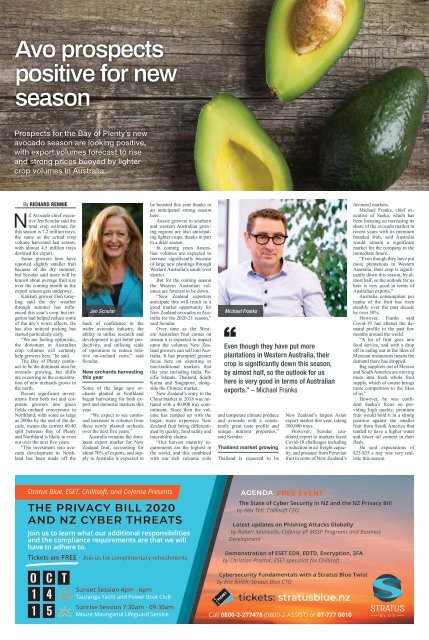October/November 2020 - Bay of Plenty Business News
From mid-2016 Bay of Plenty businesses have a new voice, Bay of Plenty Business News. This new publication reflects the region’s growth and importance as part of the wider central North Island economy.
From mid-2016 Bay of Plenty businesses have a new voice, Bay of Plenty Business News. This new publication reflects the region’s growth and importance as part of the wider central North Island economy.
Create successful ePaper yourself
Turn your PDF publications into a flip-book with our unique Google optimized e-Paper software.
<strong>October</strong>/<strong>November</strong> <strong>2020</strong> BAY OF PLENTY BUSINESS NEWS 5<br />
Avo prospects<br />
positive for new<br />
season<br />
Prospects for the <strong>Bay</strong> <strong>of</strong> <strong>Plenty</strong>’s new<br />
avocado season are looking positive,<br />
with export volumes forecast to rise<br />
and strong prices buoyed by lighter<br />
crop volumes in Australia.<br />
By RICHARD RENNIE<br />
NZ Avocado chief executive<br />
Jen Scoular said the<br />
total crop estimate for<br />
this season is 7.2 million trays,<br />
the same as the actual crop<br />
volume harvested last season,<br />
with almost 4.5 million trays<br />
destined for export.<br />
Some growers here have<br />
reported slightly smaller fruit<br />
because <strong>of</strong> the dry summer,<br />
but Scoular said more will be<br />
known about average fruit size<br />
over the coming month as the<br />
export season gets underway.<br />
Katikati grower Don Grayling<br />
said the dry weather<br />
through summer has influenced<br />
this year’s crop, but irrigation<br />
had helped reduce some<br />
<strong>of</strong> the dry’s worst effects. He<br />
has also noticed picking has<br />
started particularly early.<br />
“We are feeling optimistic,<br />
the downturn in Australian<br />
crop volumes will certainly<br />
help growers here,” he said.<br />
The <strong>Bay</strong> <strong>of</strong> <strong>Plenty</strong> continues<br />
to be the dominant area for<br />
avocado growing, but shifts<br />
are occurring as the concentration<br />
<strong>of</strong> new orchards grows in<br />
the north.<br />
Recent significant investments<br />
from both iwi and corporate<br />
growers into green<br />
fields orchard conversions in<br />
Northland, with some as large<br />
as 200ha by the end <strong>of</strong> the decade,<br />
means the current 60:40<br />
split between <strong>Bay</strong> <strong>of</strong> <strong>Plenty</strong><br />
and Northland is likely to even<br />
out over the next five years.<br />
“The investment into avocado<br />
development in Northland<br />
has been made <strong>of</strong>f the<br />
Jen Scoular<br />
back <strong>of</strong> confidence in the<br />
wider avocado industry, the<br />
ability to utilise research and<br />
development to get better productivity,<br />
and utilising scale<br />
<strong>of</strong> operations to reduce relative<br />
on-orchard costs,” said<br />
Scoular.<br />
New orchards harvesting<br />
this year<br />
Some <strong>of</strong> the large new orchards<br />
planted in Northland<br />
began harvesting for both export<br />
and domestic markets this<br />
year.<br />
“We expect to see continued<br />
increases in volumes from<br />
these newly planted orchards<br />
over the next five years.”<br />
Australia remains the dominant<br />
export market for New<br />
Zealand fruit, accounting for<br />
about 70% <strong>of</strong> exports, and supply<br />
to Australia is expected to<br />
be boosted this year thanks to<br />
an anticipated strong season<br />
here.<br />
Aussie growers in southern<br />
and western Australian growing<br />
regions are also anticipating<br />
lighter crops, thanks in part<br />
to a drier season.<br />
In coming years Australian<br />
volumes are expected to<br />
increase significantly because<br />
<strong>of</strong> large new plantings through<br />
Western Australia’s south-west<br />
district.<br />
But for the coming season<br />
the Western Australian volumes<br />
are forecast to be down.<br />
“New Zealand exporters<br />
anticipate this will result in a<br />
good market opportunity for<br />
New Zealand avocados in Australia<br />
for the <strong>2020</strong>-21 season,”<br />
said Scoular.<br />
Over time as the Western<br />
Australian fruit comes on<br />
stream it is expected to impact<br />
upon the volumes New Zealand<br />
growers can sell into Australia.<br />
It has prompted greater<br />
focus here on exporting to<br />
non-traditional markets that<br />
this year including India, Pacific<br />
Islands, Thailand, South<br />
Korea and Singapore, alongside<br />
the Chinese market.<br />
New Zealand’s entry to the<br />
China market in 2018 was initiated<br />
with a 40,000 tray commitment.<br />
Since then the volume<br />
has ramped up with the<br />
larger, more expensive New<br />
Zealand fruit being differentiated<br />
by quality, food safety and<br />
traceability claims.<br />
“Our harvest maturity requirements<br />
are the highest in<br />
the world, and this combined<br />
with our rich volcanic soils<br />
Michael Franks<br />
Even though they have put more<br />
plantations in Western Australia, their<br />
crop is significantly down this season,<br />
by almost half, so the outlook for us<br />
here is very good in terms <strong>of</strong> Australian<br />
exports.” – Michael Franks<br />
and temperate climate produce<br />
and avocado with a consistently<br />
great taste pr<strong>of</strong>ile and<br />
unique nutrient properties,”<br />
said Scoular.<br />
Thailand market growing<br />
Thailand is expected to be<br />
New Zealand’s largest Asian<br />
export market this year, taking<br />
300,000 trays.<br />
However, Scoular cautioned<br />
export to markets faced<br />
Covid-19 challenges including<br />
a reduction in air freight capacity,<br />
and pressure from Peruvian<br />
fruit in some <strong>of</strong> New Zealand’s<br />
favoured markets.<br />
Michael Franks, chief executive<br />
<strong>of</strong> Seeka, which has<br />
been focusing on increasing its<br />
share <strong>of</strong> the avocado market in<br />
recent years with its premium<br />
branded fruit, said Australia<br />
would remain a significant<br />
market for the company in the<br />
immediate future.<br />
“Even though they have put<br />
more plantations in Western<br />
Australia, their crop is significantly<br />
down this season, by almost<br />
half, so the outlook for us<br />
here is very good in terms <strong>of</strong><br />
Australian exports.”<br />
Australia consumption per<br />
capita <strong>of</strong> the fruit has risen<br />
steadily over the past decade<br />
by over 50%.<br />
However, Franks said<br />
Covid-19 has altered the demand<br />
pr<strong>of</strong>ile in the past few<br />
months around the world.<br />
“A lot <strong>of</strong> fruit goes into<br />
food service, and with a drop<br />
<strong>of</strong>f in eating out in the likes <strong>of</strong><br />
Mexican restaurants means the<br />
demand there has dropped.<br />
Big suppliers out <strong>of</strong> Mexico<br />
and South America are moving<br />
more into fresh whole fruit<br />
supply, which <strong>of</strong> course brings<br />
more competition to the likes<br />
<strong>of</strong> us.”<br />
However, he was confident<br />
Seeka’s focus on providing<br />
high quality, premium<br />
fruit would hold it in a strong<br />
position against the smaller<br />
fruit from South America that<br />
tended to have a higher water<br />
and lower oil content in their<br />
flesh.<br />
He said expectations <strong>of</strong><br />
$25-$35 a tray was very realistic<br />
this season.

















